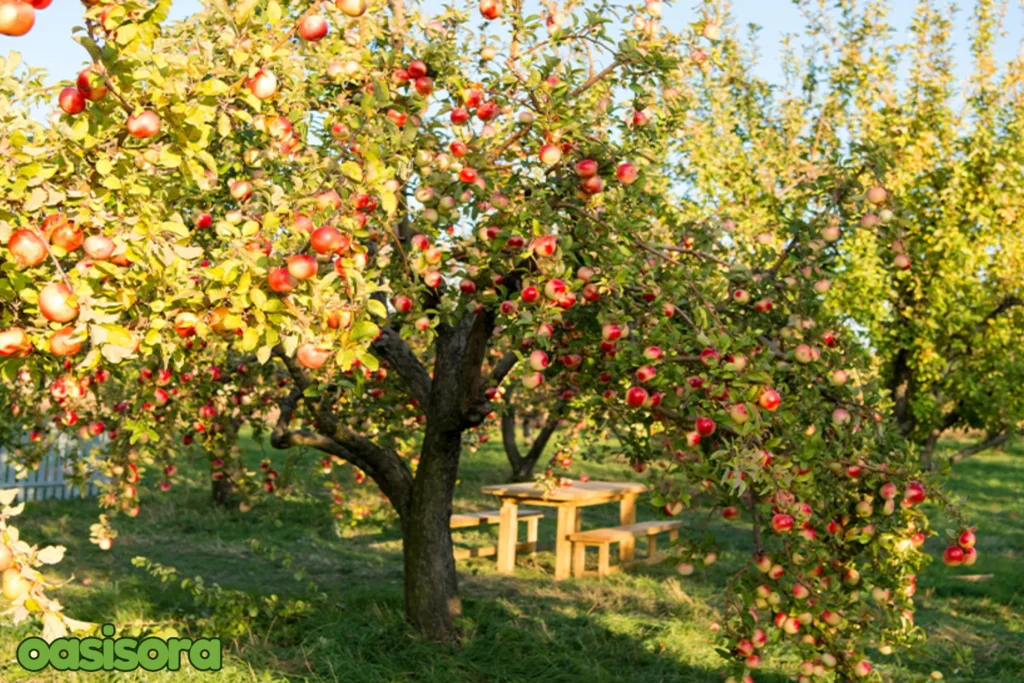
You can update your outside area into a colorful, productive, and healthy natural oasis by applying the perfect landscaping ideas with fruit trees in the garden. Planting such trees upgrades both the aesthetic appeal and practicality, no matter the size of your outdoor area.
They produce fresh, organic fruit that nourishes local animals and promotes the overall worth of your area. Let’s examine the valuable decorating ideas with fruit trees to get suggestions for beautifying your outdoor yard.
Benefits of Landscaping with Fruit Trees
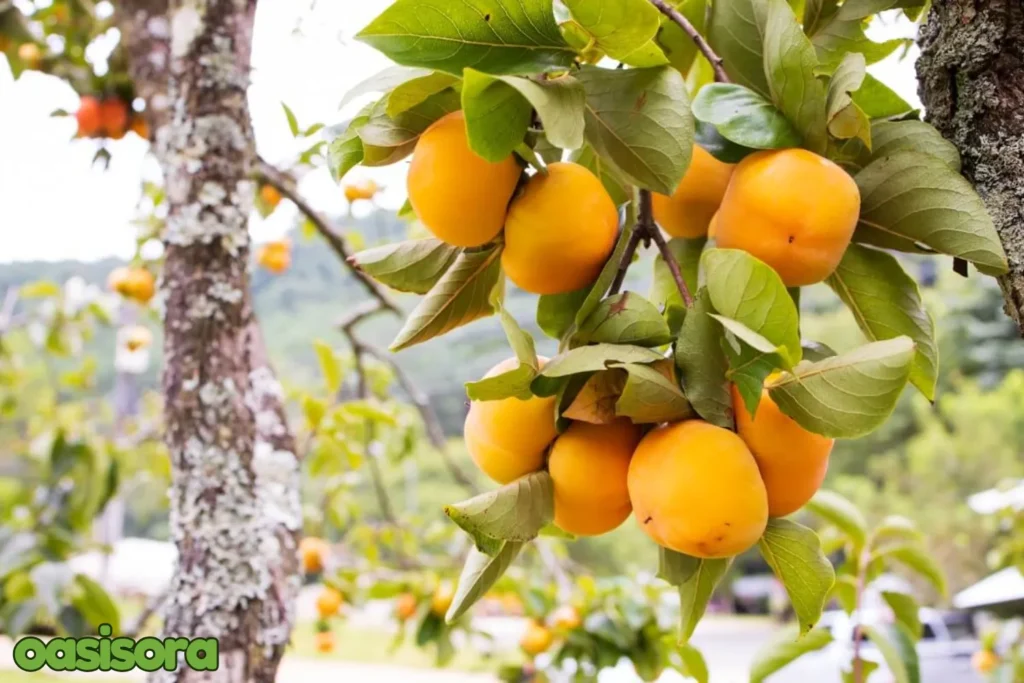
Persimmon Fruit tree Landscaping
Setting your outdoor site with fruit trees possesses several benefits for the surroundings and for you as well. Let’s discuss some of the reasons to add these trees to the layout of your garden.
1. Nutritional & Aesthetic Value
Fruit trees add artistic value to your setting with their bright colors and unique forms, while also producing fresh and productive fruit.
Moreover, homegrown fruits are beneficial for health, free of pesticides, and contain many useful substances. The selection of different kinds gives you the pleasure of various colors and textures while gaining the advantages of home plants.
2. Environmental Impact
As these trees absorb carbon dioxide and exhale oxygen so they are the valuable source of purifying the air. Their deep root networks strengthen the general health and fertility of the soil while saving lots of nutrients.
Additionally, they nourish pollinators and birds, contributing to biodiversity. Fruit trees improve the looks of your surroundings while providing many health advantages and making the area around you strong and fresh.
3. Cost-Effectiveness
Spending on fruit trees is a cost-efficient strategy that brings in fresh harvest every year. Cultivating your fruits instead of buying them from the store helps in reducing your expenses.
Moreover, domesticated fruits are naturally pure and free from chemicals, which helps save costs on buying different nutritional foods.
Through regular attention, and applying landscaping ideas with fruit trees, such plantations remain fruitful for a lengthy period making them an affordable and practical choice.
1. Choosing the Favorble Fruit Trees for Your Landscape
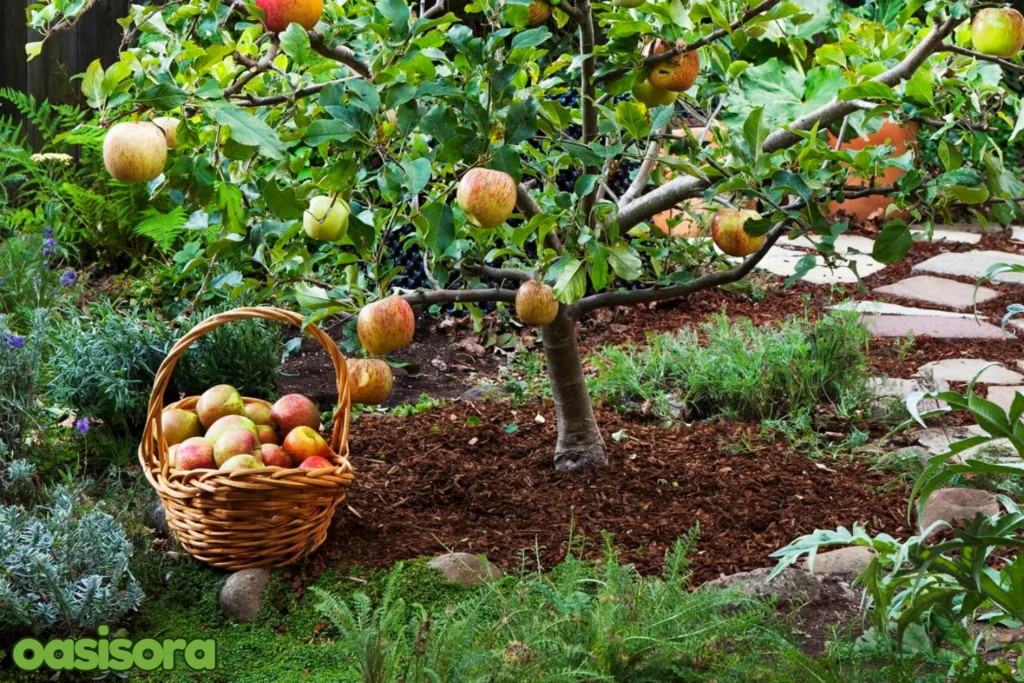
Favorble Fruit Trees for Your Landscape
As specific types are suitable for particular climates so choose them accordingly. Take these features into account while deciding fruit trees for your landscape:
Climate Compatibility:
Fruit trees that are best suitable for your region and their temperature ensure solid growth and excessive production. In warm areas, citrus fruits and pomegranates grow easily whereas colder zones are ideal for apples and pears. Consulting your hardiness zone helps in making choices appropriately.
Space Considerations:
There are different varieties available as full-size plants, semi-dwarf, or dwarf trees. Select them according to the space available in your yard.
While full-size trees need plenty of room to spread their branches, dwarf trees are appropriate for little gardens and containers. The yield of fruit and airflow get better by sufficient spacing and following the landscaping ideas with fruit trees.
Pest-Resistant Varieties:
identifying fruit trees that are resistant to pests eliminates the requirement for toxic pesticides and simplifies maintenance. Common pests are usually discouraged by varieties such as those resistant to infectious diseases as apples, figs, or persimmons. These trees make a more sustainable garden as they promote healthy growth.
Soil Requirements:
In broad terms, fruit plants need sound, moisture-rich soil to flourish. To create optimal conditions for development, analyze your soil to find out its pH and amounts of nutrients, followed by applying modifications as needed.
Designing Your Landscape with Fruit Trees
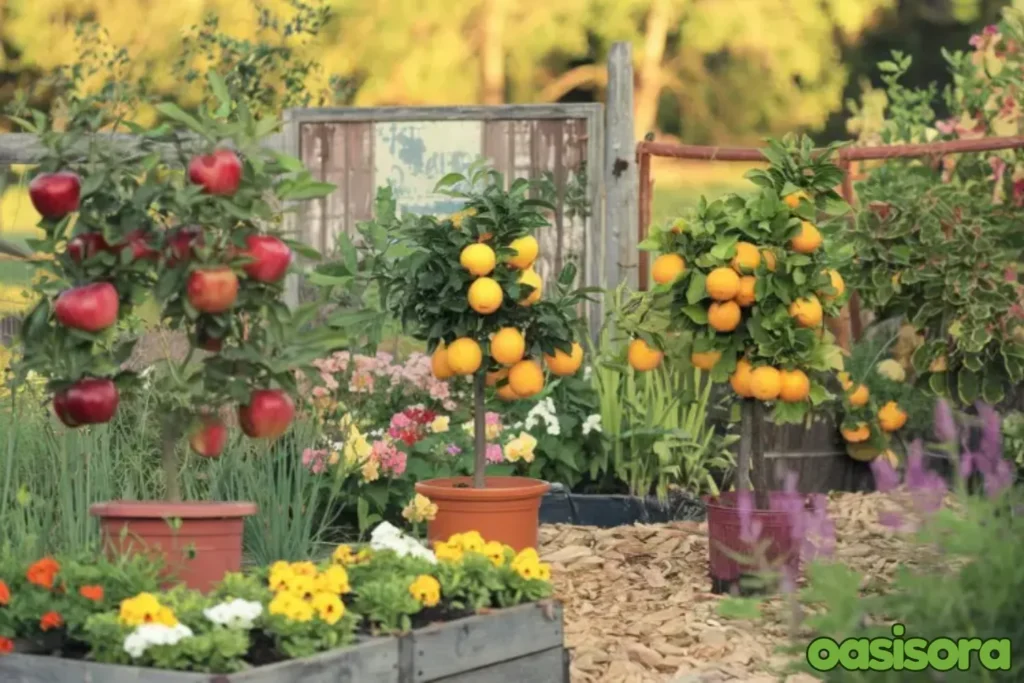
Fruit trees ideas for landscaping
Once you’ve found the most effective fruit trees for your area you’re ready to begin creating a landscape. Some basic tips will assist you in putting fruit trees into the design of your garden:
Focal Point Trees:
- Thoughtfully arranging fruit trees as central focal points may maximize the general attractiveness of your garden. A nicely arranged apple or cherry tree may provide a striking point of interest, attracting attention with its colorful fruit and in-season blooms. They can become more appealing by surrounding them with pathways or seats.
Orchard-Inspired Layouts:
- Fruit trees positioned in neat rows or clusters offer your yard a tidy and orchard-like look. This method not only improves beauty but also makes harvesting and maintenance easier. Selecting trees with varying yield schedules guarantees maximum fruit output all year long.
Vertical landscaping:
- Promote optimum use of tiny gardens or patios by utilizing space with fruit trees that are espaliered or trellised. Espalier’s methods offer trees a useful yet aesthetic element by directing them to spread flat against fences or walls. This approach still yields fresh fruit and is perfect for small settings.
Integration with Ornamentals:
- A harmonious and eye-catching environment is generated through pairing fruit trees with shrubs and blooming plants generate a pleasant and eye-catching environment. Fruit trees planted with perennials like marigolds or lavender, strengthen pollination and offer beauty and smell. Thus, implementing landscaping ideas with fruit trees builds a beautiful and prosperous garden.
2. Companion Planting with Fruit Trees
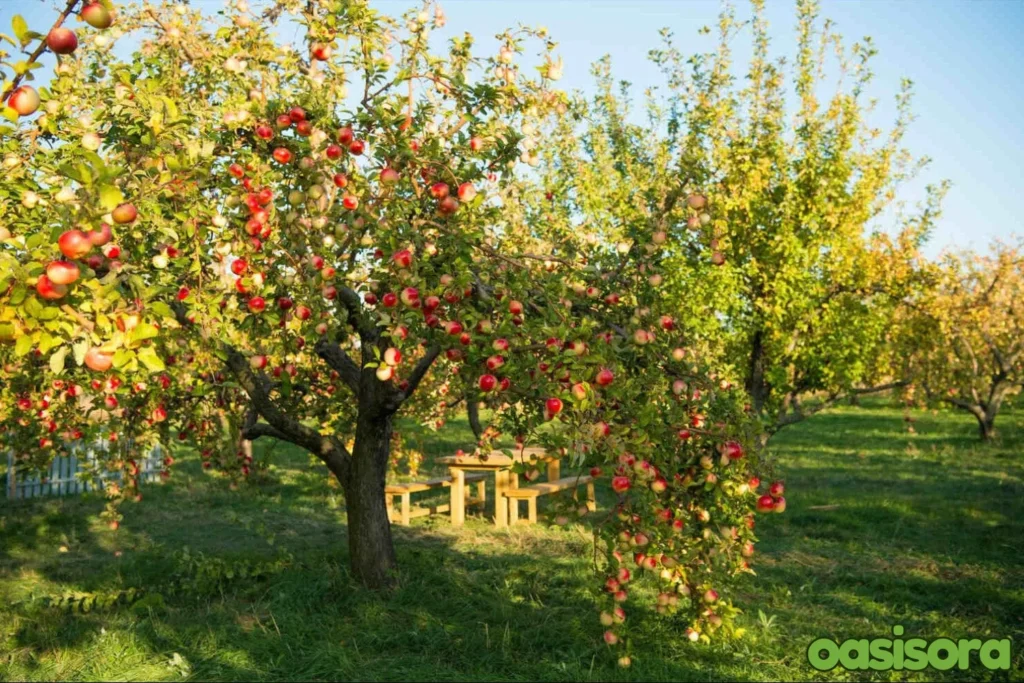
Companion Planting with Fruit Trees
Pairing different plants improves fruit trees’ growth, well-being, and output for developing a balanced ecology. Securing soil usability, making arrangements to attract useful bugs, and avoiding harmful insects, can boost the longevity and profitability of your garden.
Herbs and Flowers for Pest Control:
Beautiful Marigolds and Nasturtium plants covering the fruit trees can effectively protect them from common harmful pests like nematodes and aphids.
Additionally, pollinators like bees are attracted to these blooms, supporting fruit development. Rosemary and basil may also improve biodiversity by keeping away dangerous insects through their smell feature.
Nitrogen-Fixing Plants:
Legumes including beans, and peas organically fix the soil nitrogen, which is necessary for the growth of fruit trees. Nitrogen-fixing plants wrapping around these trees possibly improve the overall quality of the soil, facilitate healthy root development, and reduce their dependence on synthetic fertilizers.
3. Planting Techniques for Fruit Trees in Landscaping
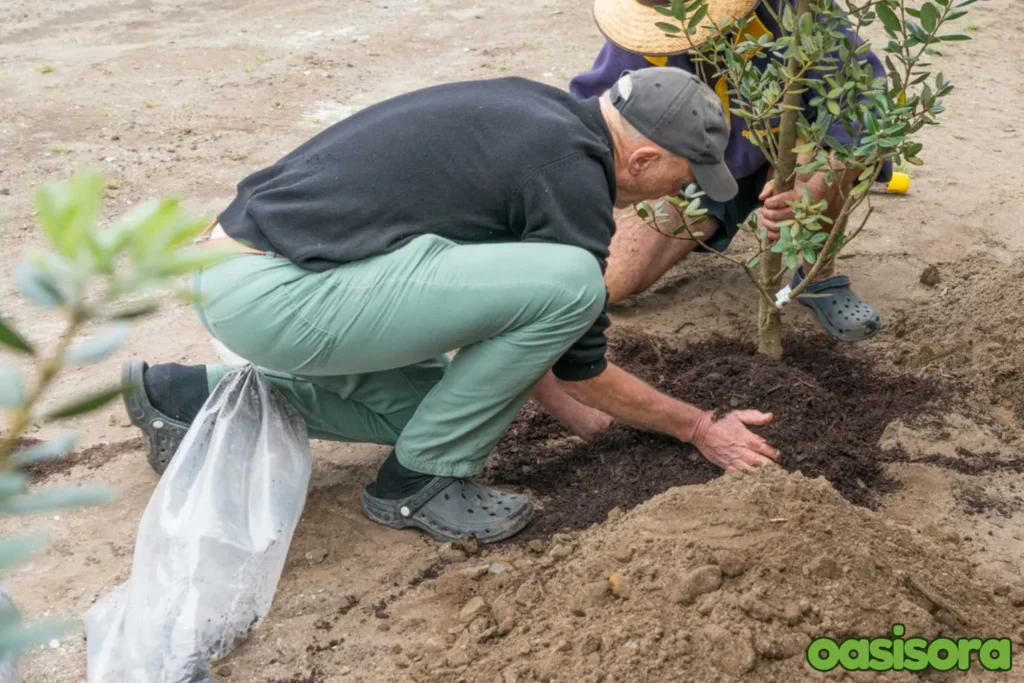
Planting Techniques for Fruit Trees
Using the right cultivation techniques and significant landscaping ideas with fruit trees is the key to successfully merging fruit trees into your environment. You can make sure that your plants develop well and prosper in their new surroundings by following these guidelines:
Site Preparation
Proper land setup is necessary for the adequate nourishment of the fruit trees. It involves selecting a space with sufficient sunlight, making sure of accurate drainage, and the availability of quality of the soil.
Soil Testing:
- A soil test is necessary to verify the pH and other contents of soil. Fruitful trees usually thrive best in soil that is nutritious and not overly acidic to neutral. For better growth, add manure or similar organic matter to the soil as needed.
Drainage Solutions:
- For the prevention of root rot, check that there is enough drainage. If the land retains too much water try installing raised beds or modifying the soil with sand and organic matter to facilitate drainage.
Sunshine Exposure:
- A great deal of fruit trees demand six to eight hours of bright sunshine every day. To support productive growth and optimize fruit output, locate a spot that gets full sun exposure.
Planting Steps
Extract the Plant:
- Always pull the tree with care out of the container or burlap. If the plant is in a pot or container, gently lift it from the bottom by tapping the sides. To secure the roots of trees wrapped in burlap, carefully remove away the cloth.
Loosen the Root Ball:
- If the outermost roots get caught or circling, simply pull them apart. This triggers the roots to expand out into the soil preventing them from sticking to a circle inside the hole. Fresh, sharp pruning tools can efficiently trim any broken or overly long roots.
Place the Tree:
- Set the plant in the hole precisely at the same depth as it was when it was growing in its burlap or container. Ensure perfect ground level for the roots flare, which occurs when the roots start to expand out from the trunk.
- To achieve a suitable height, adjust the soil under the root ball and also check for sufficient spacing.
Backfill the Hole:
- If you wish, you can mix compost into the dug soil as you fill it in. To effectively get rid of air spaces, cover halfway and then gently squeeze down the particles. To lend the roots support, proceed to fill the hole and carefully press the earth layer around them. Stop pressing the soil too much as it may hinder roots from growing.
Water Completely:
- To make the soil settle while getting rid of any remaining air pockets, water the tree completely after filling the hole. Make sure it reaches the roots evenly.
Caring for Young Trees
For fruit trees to stay thriving and productive in the long term, regular upkeep and utilizing landscaping ideas with fruit trees are essential. Here are some specific indicators:
Frequent Watering:
- Particularly in the beginning phases, young trees require regular watering. Irrigate roots gently and deeply but prevent them from water logging. Generally, sufficient watering once or twice a week is adequate. However, the watering schedule should be followed according to your region and soil type.
Mulching
- Apply a mulch layer like bark dust to protect your tree’s base, but avoid piling it against the trunk. It helps minimize rot and pest issues.
Protecting Against Frost:
- To safeguard young trees from extreme cold, it’s good to prefer burlap or frost wrappings. Growing trees in protected areas may minimize frost damage, and mulching further helps insulate roots.
4. Vertical Fruit Trees for Small Spaces
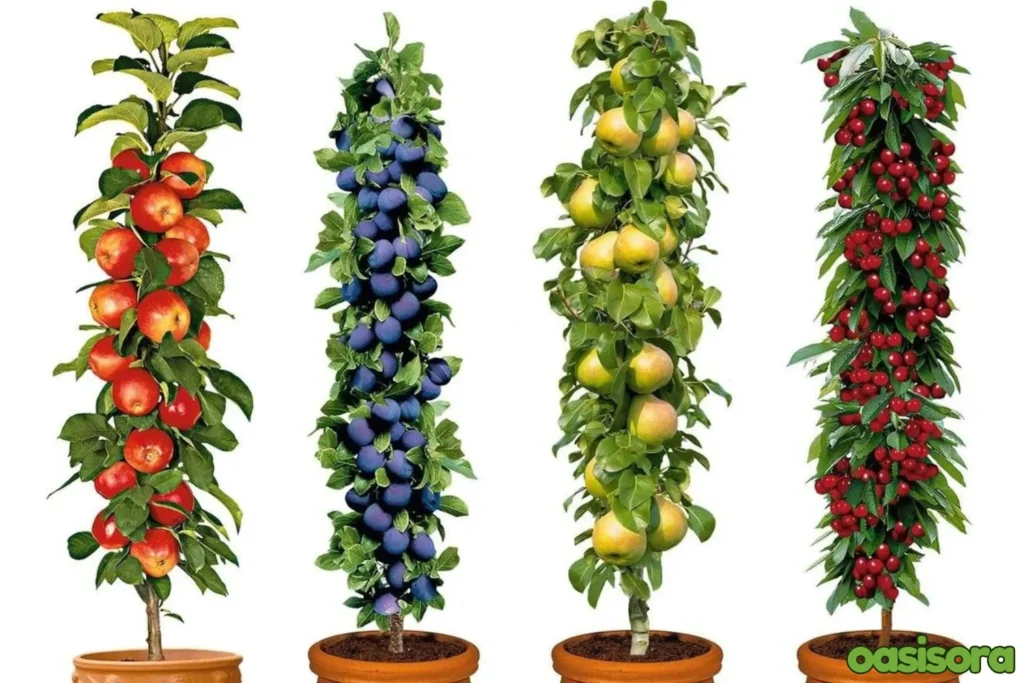
Vertical Fruit Trees Landscaping
Small spaces don’t mean compromising fruit production and lack aesthetics. Fruiting plants can grow successfully in tiny environments using vertical planting techniques.
Espalier Techniques:
For compact areas, you can add a beautiful touch by arranging fruit trees to grow straight against a wall or trellis. This approach facilitates harvesting, balances air circulation, and increases direct sun exposure for plants. For espalier, apple, pear, and fig trees are excellent alternatives.
Dwarf Varieties for Compact Gardens:
Small patios and yards are perfect for tiny fruit trees, such as dwarf citrus, apples, and peaches. They continue to produce full-sized fruits, fit in containers, and need minimal trimming.
5. Creating Seasonal Interest with Fruit Trees
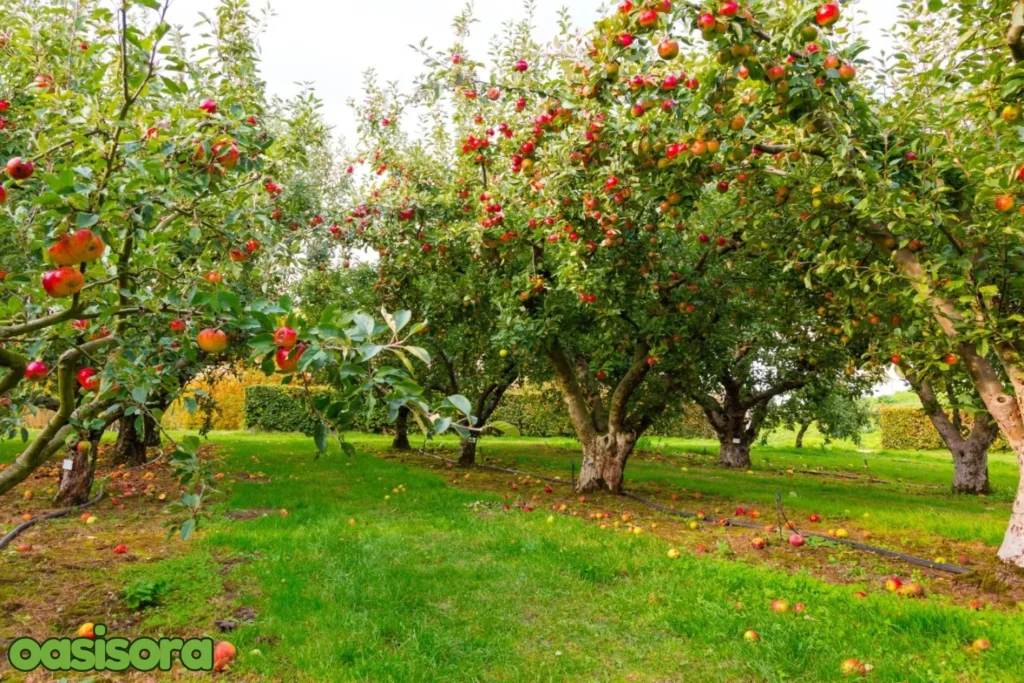
Seasonal Interest with Fruit Trees
These useful trees deliver consistent elegance by modifying the environment with seasons and providing delicious harvests.
Spring Blossoms:
A lot of fruit trees, particularly peach, apple, and cherry, produce lovely flowers in the spring to attract pollinators while offering amazing shades. Their sweet fragrances create a charming and green garden atmosphere.
Fall Foliage & Fruit Harvest:
Ripe, nutritious fruits by trees such as apples, and pears, develop bright autumnal colors. For both visual interest and plentiful crops, the fall season is best because of their gold, crimson, and different color leaves that increase the value of your natural world.
6. Maintenance Tips for a Thriving Fruit Tree Landscape
Managing the plants’ health and productivity involves constant attention. To preserve your fruit tree landscape prospering, follow these thorough maintenance tips.
Pruning and Training
Regular grooming and trimming maintain the structure, strength, and production of the trees. Retaining the form, health, and fruit output of your fruit trees requires regular pruning that helps healthy growth and safeguards against disease.
Raising New Trees:
- Cutting up branches strategically will help shape young trees. Create a strong basis for assisting with fruit production in the future.
Pruning Every Year:
- Every year, cut down the sick, dead, or damaged branches. Improves air circulation, supports new growth, and upgrades the appearance of trees. Reduce the possibility of illness and encourage healthful fruit production.
Pruning for the Dormant Season:
- To minimize pressure on plants, trim in the late winter or early spring. Work for the general health of trees and stop excessive fluid loss.
Pest & Disease Management
Fruit trees are at risk of various pests and diseases, but with sufficient care and proper practice landscaping ideas with fruit trees, they may stay sturdy and fruitful. Preventing fatal diseases and bugs requires early identification and treatment.
Natural Treatments:
- Neem oil or insecticidal soap can easily control aphids and scale-like insects. These organic remedies are safe for beneficial insects and environmentally favorable varieties.
Resistant to Disease:
- Select species that are naturally unaffected by bacterial and fungal problems. Facilitates the management of illnesses and lowers the need for harmful chemicals.
Garden Cleanliness:
- To avoid pest problems, sweep up fallen fruit, leaves, and waste regularly. For improved air circulation and decreased humidity near foliage, keep trees planted properly at specific distances.
Watering & Fertilizing
Frequent thorough watering and recommended fertilizers help in achieving strong root growth.
Time to fertilize:
- The use of an organic fertilizer in early spring or mid-summer provides essential minerals for consistent growth and rich crop production.
Long-Term Health of Trees:
- Overall tree viability is ensured by consistent fertilization and watering. Guarantee the long tree life span enhances resistance against adverse conditions and production over time.
7. Adding Fruit Trees to Urban Landscapes
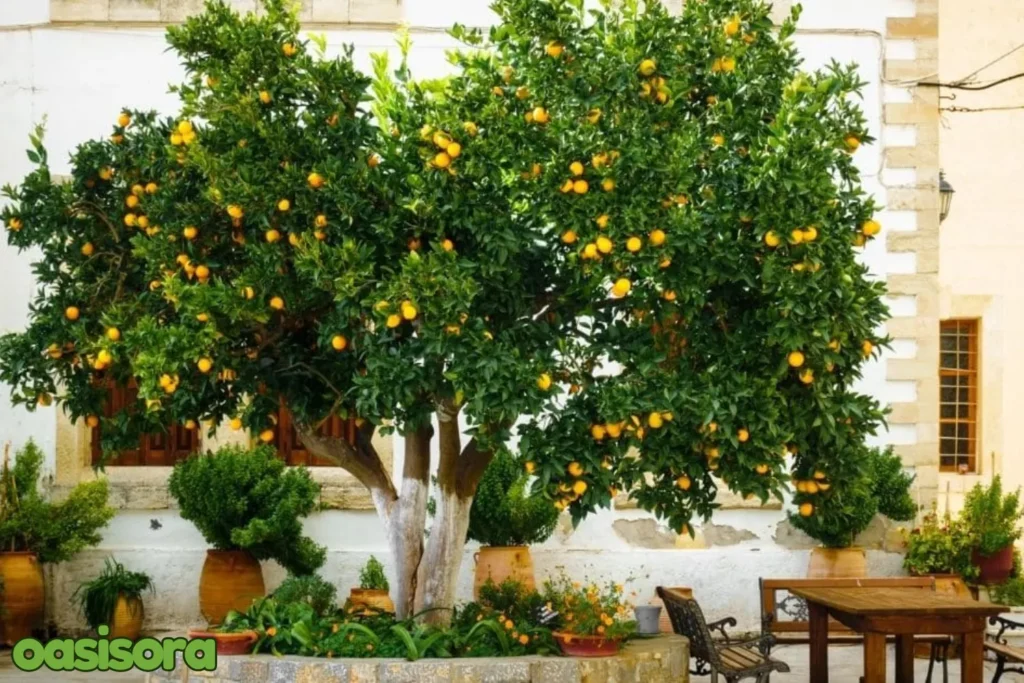
Fruit trees for Urban areas
With correct methods, fruit trees can grow well in urban environments although there may not be sufficient space. Whether the plants are grown in tiny yards or a profitable harvest is possible by adopting the right kinds while making sure that proper pollination occurs.
Growing in Containers:
To promote strong root development, choose sizable containers with rich nutrients soil and precise drainage system. Potted fruit trees can thrive in small places with consistent fertilization and watering.
Selecting Compact Varieties:
For patios and tiny yards, use dwarf or upright fruit tree species like Meyer lemon or dwarf apple. Such trees provide fruits although they take up a small space.
Pollination Tips:
Use self-pollinating trees or put appropriate types near one another for adequate pollination. Insert blooming plants into your urban garden to attract pollinators, such as bees.
8. Edible Privacy Screens
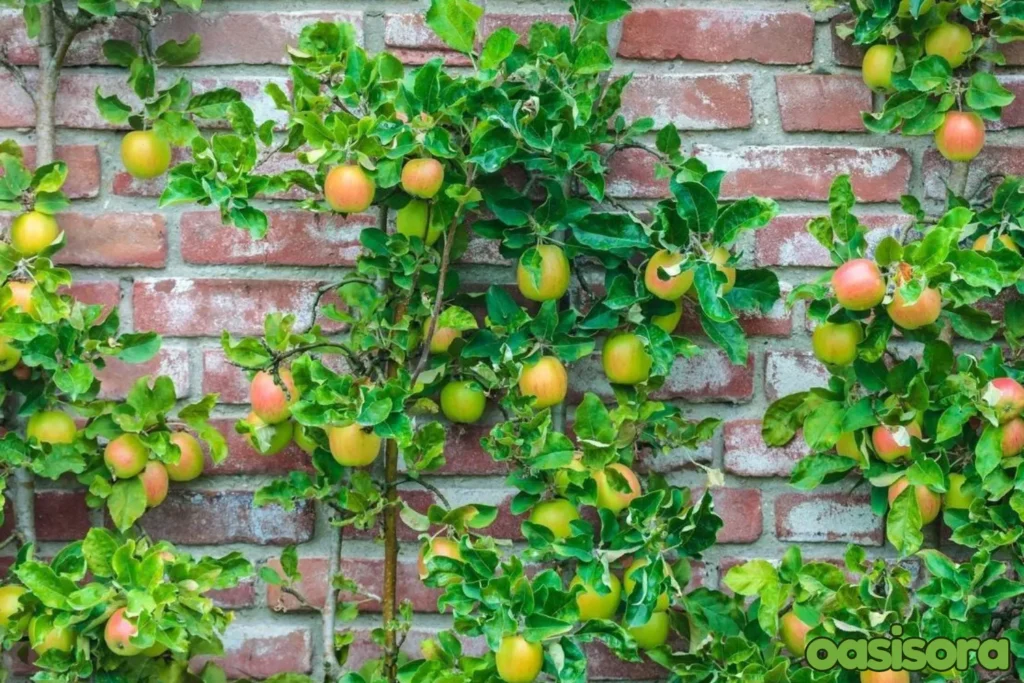
Edible Privacy Hedges fruit trees
Besides offering fresh fruits, these trees can also offer privacy. Mixing them with shrubs or planting them strategically as hedges according to the landscaping ideas with fruit trees can establish a landscape that is both beautiful and practical.
Using Fruit Trees as Hedges:
Plant fruit trees close to each other to build a natural privacy boundary. Apple or pomegranate trees are solutions that can give you seasonal fruit and serve as a lush, green screen.
Layering Trees with Shrubs:
To produce a multi-layered, fruitful border, combine fruit trees with vegetation like berry bushes. This optimizes the space for edible plants while maintaining isolation.
9. Common Landscaping Mistakes with Fruit Trees
Suitable preparation is necessary when planting fruit trees to avoid usual mistakes that might affect their development and yield. Here are some significant risk indicators to be aware of:
Overcrowding:
- Fruit trees demand considerable amounts of area so that their branches can receive enough sunshine and their roots can spread out. If they are set up near to one another, that restricts airflow which may end in poor fruit growth and an increased possibility of diseases.
Improper Watering:
- Insufficient irrigation or overwatering both harm the plants. While deficiency of required moisture might cause stress and limit fruit output, excessive water may give rise to root rot. So it’s important to maintain a regular watering schedule.
Ignoring Pollination Needs:
- To allow growth in specific tree species, cross-pollination is essential. Low or no fruit yield can arise from planting unsuitable types or from an inability to draw pollinators. Verify the pollination requirements of the trees you have selected for regular production.
Conclusion
Introducing fruit trees to your garden is a wonderful approach that boosts both looks and usability. You can benefit from fresh, local fruits while constructing a visually pleasing setting using the above landscaping ideas with fruit trees.
Whether they serve as centers of attention, private screens, or in tiny urban gardens, fruit plants provide multiple advantages, such as shade, biodiversity, and long-term savings.
Your outdoor area can develop into a prospering and durable haven if you choose the proper kinds and take good care of them.
FAQs
How should we find the best fruit tree according to our location?
Find the most suitable type based on your landform and climatic conditions in your area. For a better option, consult your local farming extension office or greenhouses and nurseries.
Can we grow fruitful trees in small places or containers?
Dwarf or semi-dwarf plants can perfectly improve your narrow spaces. For optimal development, use nutrient-rich soil in large, well-draining pots.
In what period do trees start producing fruit?
Depending on the kind and its developmental atmosphere, most fruit trees typically require 2-5 years to bear fruit.
Which season is best to plant fruit trees?
Planting in the fall or early spring enables the root to mature before harsh cold weather arrives.
